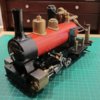Cookie's home for Waifs, Strays, Unloved and Unfinished Projects (WSUUP's)
Despite running an extremely successful breeding program for the aforementioned, I still find it impossible to resist the temptation to re-home somebody else's unfinished projects. The latest 'rescue' involves a 16mm Association Victory project engine, something I've been trying to track down for ages. As is usual, when I had the opportunity to sign up and buy one I didn't, now I'm struck by the body style and want one, they never appear for sale

Anyway, after a good 18 months of waiting, an unfinished one turned up locally so I went round to see it. Chassis wise its OK, it needs retiming a bit, but it rolls freely enough and looks to have gone together OK.

Its not staying like this of course

Having spoken to Roundhouse during the week, I've been able to order a pair of their Darjeeling B Class cylinders so I can have the steam chests leaning out as per the prototype.

I'll have to modify the existing valvegear to suit, but I think its only a question of changing the radius rods so they bend away from the engine as opposed to the current inboard bend.
The body is a sad story unfortunately, needing a bucket load of rectification work.

To be fair, it was the chaps first soldered body and given the thickness of materials, he just didn't have sufficient heat to do the job properly. Compounding the heat issue is that all of the parts have been bent the wrong way (so the etched lines are on the outside of the bend) and none of the cusps have been removed so nothing really fits snugly. I did have a quick look at trying to resolve it as it stood, but a top down view shows that despite being built on a jig, the body is just not square is any dimension.

There are also gaps where there shouldn't be any whilst the detail parts have been superglued on (ish..)

In the end I just decided it would be better to start from scratch, so fired up the blow torch and took it back to its component pieces.

The critical parts such as cab front and rear panels, plus the tank sides and tops are all salvageable with a little cleaning up and filing. Everything else is going to need a good clean and reforming to get it to fit properly, a trial piece has shown that the brass starts to fracture if the bend is undone and then performed correctly. I could remake the affected parts, but it seems quicker to anneal and clean, than recut from raw materials. The blow torch came out again this morning and a few minutes were spent warming the parts up.


A trial on some of the practise parts has showed this works out moderately well, I'll wait until everything has cooled down before giving it a go.
Its more work than I hoped for, but its the only option that has presented itself and it does represent a significant saving over the original cost of the components. How well it fares against all the other WSUUP's remains to be seen - if nothing else it takes up less space when packed away

Steve











 .
.






